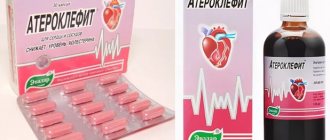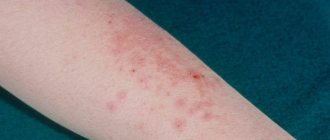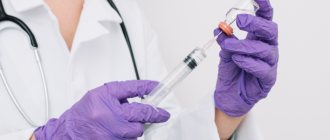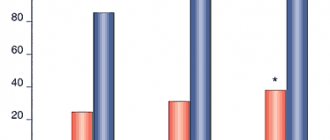Allapinin 25 mg 30 pcs. pills
pharmachologic effect
Antiarrhythmic drug.
Composition and release form Allapinin 25 mg 30 pcs. pills
Tablets - 1 tablet:
- Active substance: Lappaconitine hydrobromide with accompanying alkaloids (Allapinin®) (calculated as 100% substance) - 0.025 g; Lappaconitine hydrobromide with accompanying alkaloids (Lappaconitine hydrobromide) (calculated as 100% substance) - 0.025 g;
- Excipients: Sucrose (sugar), or refined sugar, or granulated sugar - 0.0655 g; Potato starch (extra grade) - 0.0075 g; Calcium stearate - 0.001 g; Croscarmellose sodium - 0.001 g; Tablet weight - 0.1 g.
Tablets, 25 mg.
10 or 30 tablets in a blister pack made of polyvinyl chloride film and printed varnished aluminum foil.
One, two, three or five blister packs No. 10 or one blister pack No. 30, together with instructions for medical use, are placed in a cardboard pack for consumer packaging.
Description of the dosage form
The tablets are round, biconvex, white.
Directions for use and doses
Inside, after eating, with a small amount of water at room temperature, do not crush.
Take 1 tablet (25 mg) every 8 hours, if there is no therapeutic effect - every 6 hours.
It is possible to increase the single dose to 2 tablets (50 mg) every 6-8 hours. The maximum daily dose is 300 mg (12 tablets).
The duration of treatment and correction of the dosage regimen (increasing the dose) is determined by the doctor.
Pharmacodynamics
Pharmacological properties
Allapinin® is a hydrobromic salt of the alkaloid lappaconitine with accompanying alkaloids, obtained from the grass of the white-mouthed fighter - Aconitum leucostomum Worosch. and rhizomes with roots of the northern fighter (high fighter) Aconitum septentrionale Koelle (A. excelsum Reichenb.), fam. Ranunculaceae - Ranunculaceae.
Pharmacodynamics
Class IC antiarrhythmic drug.
Blocks “fast” sodium channels of cardiomyocyte membranes. Causes a slowdown in atrioventricular (AV) and intraventricular conduction, shortens the effective and functional refractory periods of the atria, AV node, His bundle and Purkinje fibers, does not affect the duration of the QT interval, conduction through the AV node in the anterograde direction, heart rate (HR) and blood pressure (BP), myocardial contractility (in the initial absence of symptoms of heart failure). It does not inhibit the automatism of the sinus node, does not have a negative inotropic effect, and does not have an antihypertensive or m-cholinolytic effect.
It has a moderate antispasmodic, coronary dilation, local anesthetic and sedative effect.
When taken orally, the effect develops after 40-60 minutes, reaches a maximum after 4-5 hours and lasts 8 hours or more.
Pharmacokinetics
When taken orally, lappaconitine hydrobromide is rapidly absorbed from the gastrointestinal tract, the maximum concentration in the blood plasma is achieved on average after 80 minutes. The bioavailability of lappaconitine hydrobromide is 56%, which is associated with the effect of “first pass” through the liver. The main pharmacologically active metabolite is desacetyllappaconitine. The half-life (T1/2) is 1.2-2.4 hours. With prolonged oral use, an increase in T1/2 is possible.
In chronic renal failure, T1/2 increases 2-3 times, in liver cirrhosis - 3-10 times.
In chronic heart failure of functional class II-III according to the NYHA classification, the absorption of lappaconitine hydrobromide is slow (the maximum concentration in the blood plasma is reached after 2 hours). It is excreted by the kidneys in a modified form (up to 28%), the rest through the intestines.
Indications for use Allapinin 25 mg 30 pcs. pills
Supraventricular and ventricular extrasystole, paroxysms of atrial fibrillation and flutter; paroxysmal supraventricular tachycardia, including in Wolff-Parkinson-White syndrome (WPW), paroxysmal ventricular tachycardia (in the absence of organic changes in the myocardium).
Contraindications
Hypersensitivity to the drug, sinoatrial block, AV block II and III degrees (without an artificial pacemaker), cardiogenic shock, right bundle branch block combined with blockade of one of the branches of the left leg, severe arterial hypotension (systolic blood pressure less than 90 mm Hg. Art.), moderate and severe chronic heart failure of functional class III-IV according to the NYHA classification, severe hypertrophy of the left ventricular myocardium (≥1.4 cm), the presence of post-infarction cardiosclerosis, severe dysfunction of the liver and/or kidneys, age under 18 years ( efficacy and safety have not been established), fructose intolerance and glucose/galactose malabsorption syndrome or sucrase/isomaltase deficiency (the drug contains sucrose).
Use with caution in case of 1st degree AV block, intraventricular conduction disorder, sick sinus syndrome (SSNS), bradycardia, severe severe peripheral circulatory disorders, angle-closure glaucoma, benign prostatic hypertrophy, conduction disorder along Purkinje fibers, blockade of one of the bundle branches, disturbances of water and electrolyte metabolism (hypokalemia, hyperkalemia, hypomagnesemia), simultaneous use of other antiarrhythmic drugs
Application Allapinin 25 mg 30 pcs. pills during pregnancy and breastfeeding
The use of Allapinin® during pregnancy is not recommended. The use of the drug is possible only for vital indications, if the expected benefit to the mother outweighs the potential risk to the fetus/child.
There is no data on the excretion of lappaconitine hydrobromide into breast milk. The use of the drug is not recommended during breastfeeding. If use of the drug during lactation is necessary, breastfeeding should be discontinued.
special instructions
Before starting to use the drug Allapinin®, it is necessary to eliminate disturbances in water-electrolyte metabolism; during therapy, monitoring of the water-electrolyte balance of the blood is necessary.
In patients who have suffered an acute myocardial infarction or in patients with heart failure, as well as in patients with an installed artificial cardiac pacemaker, the pacemaker threshold may increase.
If headache, dizziness, or diplopia develop, the dose of Allapinin® should be reduced.
If sinus tachycardia occurs during long-term use of the drug, the use of beta-blockers (low doses) is indicated.
1 tablet of Allapinin® contains 0.074 g of carbohydrates, which corresponds to 0.01 XE (bread units).
Impact on the ability to drive vehicles and operate machinery
When using the drug, care should be taken when performing potentially hazardous activities that require special attention and quick reactions (driving vehicles, working with moving mechanisms).
Overdose
Symptoms: has a small therapeutic breadth, so severe intoxication can easily occur (especially with simultaneous use of other antiarrhythmic drugs): prolongation of PR and QT intervals, expansion of the QRS complex, increase in the amplitude of T waves, bradycardia, sinoatrial and AV block, asystole, paroxysms of polymorphic ventricular tachycardia, decreased myocardial contractility, marked decrease in blood pressure; dizziness, blurred vision, headache, gastrointestinal disorders.
Treatment: symptomatic; do not use class IA or IC antiarrhythmic drugs for the treatment of ventricular tachycardia; sodium bicarbonate can eliminate widening of the QRS complex, bradycardia and arterial hypotension.
Side effects Allapinin 25 mg 30 pcs. pills
When using the drug, dizziness, headache, a feeling of heaviness in the head, skin hyperemia, ataxia, diplopia, allergic reactions are possible, intraventricular and AV conduction disturbances, sinus tachycardia (with long-term use), arrhythmogenic effects are possible.
ECG changes: prolongation of the PQ interval, expansion of the QRS complex.
Drug interactions
Inducers of microsomal liver enzymes reduce the effectiveness and increase the risk of developing toxic effects of lappaconitine hydrobromide.
With simultaneous use of lappaconitine hydrobromide with other antiarrhythmic drugs, the risk of developing arrhythmogenic effects increases.
Lappaconitine hydrobromide enhances the effect of non-depolarizing muscle relaxants.
What does it help with?
The drug Novo-Passit is used in various fields of medicine, such as psychiatry, neurology, gastroenterology, and therapy. The drug is in greater demand in psychiatric practice.
The drug is used to treat neurasthenia and neurological reactions, which are manifested by the following symptoms:
- fear;
- anxiety;
- fatigue;
- absent-mindedness;
- irritability.
The remedy is indicated for people who are under constant mental stress. The drug effectively relieves the initial form of insomnia, improving sleep and relieving nervous tension.
Novo-Passit helps with headaches. It is also prescribed for migraines to relieve pain.
Very often, a sedative is used for neurocirculatory dystonia, as it can manifest itself as nervousness, interruptions in heart function, tachyarrhythmia and other symptoms caused by stress. The drug is actively used as an adjuvant therapy for itchy dermatoses, since itching can drive patients to hysterics. The drug is especially relevant for atopic dermatitis, seborrhea, and urticaria.
It is possible to prescribe medication for diseases of the digestive tract. It helps well with dyspepsia and irritable bowel syndrome. It is relevant to use the drug during menopause in women over 50 years of age.
Interaction with other drugs
When Novo-Passit is taken together with other medications, its pharmacological properties may be strengthened or weakened and undesirable effects may occur. The simultaneous use of different medications must be agreed with the attending physician.
Interaction:
- If taking Novo-Passit is combined with the use of alcohol-containing drinks and narcotic substances, the inhibitory mechanisms of the central nervous system are strengthened. For this reason, you should refrain from drinking alcohol during the course of therapy.
- Medicines that cause relaxation of skeletal muscles can increase the likelihood of unwanted effects of the drug Novo-Passit. They especially increase muscle weakness.
- Novo-Passit, due to the presence of St. John's wort extract, is able to reduce the effect of contraceptives, drugs for the treatment of HIV, thromboembolism, bronchopulmonary and other pathologies.
Analogs
The drug has analogues that are very similar in their effect on the body. These include:
- Glycine is a nootropic drug;
- Motherwort is a flavonoid;
- Persen is a herbal remedy;
- Notta is a homeopathic medicine;
- Tenoten is a herbal remedy;
- Afobazole is a tranquilizer.
Glycine is produced in the form of sublingual tablets. The product is classified as a nootropic. It is used for anxiety, memory loss, and absent-mindedness. The drug contains the essential amino acid glycine, which affects GABA metabolism. The remedy relieves mild symptoms of anxiety well.
Motherwort is a flavonoid. It has a sedative effect and can improve sleep, but does not affect the mechanisms of GABA and serotonin metabolism. Therefore, it is not always effective for anxiety conditions.
Notta is a homeopathic remedy. It has a tranquilizing effect. The product increases tolerance to stressful situations and normalizes sleep rhythms.
Tenoten is a nootropic sedative. It has a GABA-mimetic and neurotrophic effect, improving the conduction of nerve impulses. The product increases resistance to stress, improves memory and attention.
Persen contains lemon balm, mint, and valerian. The drug has a sedative effect, but does not affect GABA metabolism.
Afobazole belongs to the group of tranquilizers. It normalizes GABA/benzodiazepine receptors, restoring their sensitivity to endogenous inhibitory mediators. The drug relieves anxiety, irritability, and fear well. The product improves memory and attention. Afobazole is one of the most effective analogues that helps against anxiety. The cost of afobazole is 2 times higher than that of Novo-Passit.
Novo-Passit is indeed an inexpensive drug for the treatment of anxiety. The drug is actively used by psychotherapists and psychologists to relieve anxiety, fear, and irritability due to its combined composition. In addition to anxiety, the medicine is good at treating tension headaches, migraines, dyspepsia, and “irritable bowel syndrome.”
Novo-Passit
Components and form of Novo-Passit
The drug Novopassit is a herbal preparation made from natural medicinal herbs. For this reason, the likelihood of developing unwanted effects is minimized.
The main components of the drug are:
- valerian officinalis roots;
- lemon balm herb;
- herb St. John's wort;
- leaves and flowers of hawthorn or monopistillate;
- passionflower incarnate herb;
- common hop fruits;
- black elderberry flowers.
These are the main medicinal components. There are also auxiliary ones - sodium cyclamate, xanthan gum, guaifenesin and others.
Taking Medicine








